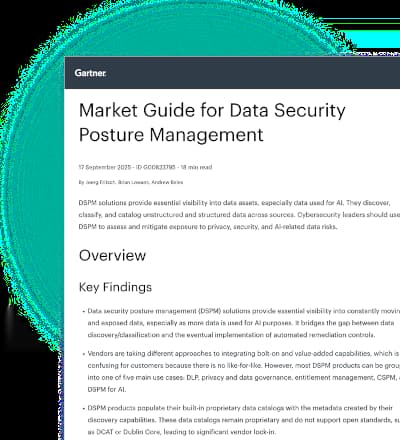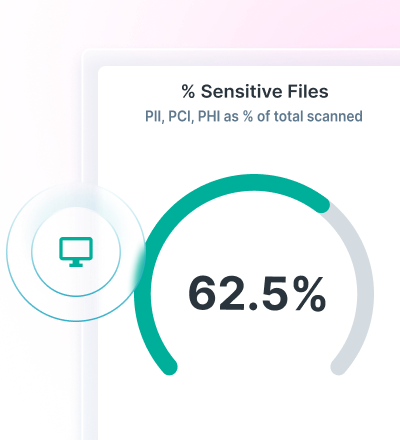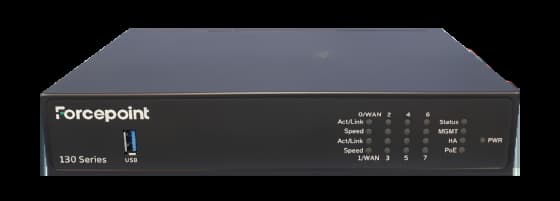
12,000 多名客户不會錯










































擴展並保護辦公室、分支機構和遠程地點的網路訪問。
廣域網路——滿足安全需求。Forcepoint Secure SD-WAN 通過零信任安全策略保護網路免受進階威脅,同時在世界任何地方保持卓越連接。
為什麼選擇 Forcepoint Secure SD-WAN?
集中管理: 從雲端中激活分支機構、辦公室和遠程位置。 一次配置策略,然後使用安全管理控制台 (SMC) 使用零接觸部署。
提高应用程序性能:减少延迟和抖动,并通过多链路连接、动态流量控制、应用程序健康监控和其他功能确保关键应用程序优先获得带宽。
防範高級威脅:通過多層檢查、入侵防禦、DNS 劫持等技術檢測和預防風險,同時通過 ZTNA 應用程序連接器保護本地或遠程應用程序的訪問。
降低運營成本:通過本地 ISP 寬帶和專用 MPLS 選擇的實時混合和匹配,大幅降低網絡成本並提高可靠性。
數據表
對比設備型號


Global Network
20+
Countries
45+
Cluster Nodes
Clustering In a Way No One Else Can Do
Christian Keller, CISO at Huber + Suhner, lists reliability, clustering, and ability to navigate global compliance requirements among the top benefits of Forcepoint NGFW.
探索 Forcepoint Secure SD-WAN 模型

2300 Series
Ideal for mid-sized and large offices.
Up to 30 interfaces
Firewall throughput up to 145 Gbps
IPS NGFW throughput up to 37 Gbps
雲端影像:
- 統一化 Forcepoint NGFW 軟體
- Amazon Web Services (AWS)
- Microsoft Azure 解決方案
- 保護進/出雲端的南北向通訊,以及 SDN 的東西向流量
虛擬設備:
- 統一化 Forcepoint NGFW 軟體
- 適用於 KVM 以及 VMware ESXi 與 NSX
- 擴充至 64 個 CPU
- 將網路微分段自動化
- 能夠與實體防火牆組成叢集
為何客戶選擇 SD-WAN
為何客戶選擇 SD-WAN
"Our costs - both for the project and maintenance - are going down because we don't need resources locally, we have centralized everything. If we want new service on a train, we define the policy then give the hardware to the operator, who installs it."
VR Group
Frequently Asked Questions
What is managed SD-WAN?
A managed SD-WAN is a service where a provider handles the deployment, configuration, monitoring and optimisation of your WAN. Meanwhile, a cloud-managed SD-WAN adds centralised control via the cloud, making it easier to apply consistent policies, improve performance and maintain security across distributed networks without internal resource strain. Learn more about this product through our comprehensive managed SD-WAN solutions guide.
What are the benefits of SD-WAN?
Benefits of Forcepoint Secure SD-WAN include the following:
Centralized management
Improved application performance
Protection against advanced threats
Reduced operating costs
How much does SD-WAN cost?
SD-WAN costs are determined by factors, including the type of deployment, the size of the network, the number of locations to connect, the type and amount of data transiting the network and any existing infrastructure that may be leveraged when deploying an SD-WAN solution.
What is SD-WAN security?
SD-WAN security helps organizations enable effortless connection to cloud resources while protecting users, data and IT environments from attack.
What is an SD-WAN solution?
Ad SD-WAN solution applies software-defined networking principles to the wide area network.
What is an SD-WAN provider?
SD-WAN providers enable organizations to deploy SD-WAN technology.
What is an SD-WAN appliance?
SD-WAN appliances are physical or virtual controllers located on-premises or in the cloud that connect an organization’s users to applications, services and workloads.
How do SD-WAN appliances work?
SD-WAN appliances and products are designed to overcome the challenges of ensuring fast and secure connectivity for branch locations and hybrid workforces. The traditional wide area network uses a hub-and-spoke model that requires all traffic to flow through a central data center. For organizations with a highly distributed workforce, this model adds unacceptable levels of latency that negatively affect user experiences and productivity. Additionally, legacy WANs are built with costly Multiprotocol Label Switching (MPLS) connections that are time-consuming to manage and deploy, preventing organizations from scaling easily and cost-efficiently. SD-WAN overcomes these issues by creating a virtual overlay for the network that abstracts network connections and enables the use of additional, low-cost transport services that add redundancy and flexibility.
What is Multiprotocol Label Switching (MPLS)?
Multiprotocol Label Switching (MPLS) is data forwarding technology that increases the speed and controls the flow of network traffic.
What is SD-WAN vs MPLS?
SD-WAN is a networking technology that uses software to make wide area networks more intelligent and flexible by connecting sites directly to the internet over commodity broadband links. Configurations and access policies are centrally managed and easily applied across all sites, removing the need to manual administer each WAN device individually. MPLS is data forwarding technology for network traffic that directs data through a path via labels instead of requiring complex lookups in a routing table at every stop. Traditional networking technology, MPLS, has seen competition from SD-WAN solutions to meet today's high demands and expanding needs for networked business-critical systems.




















